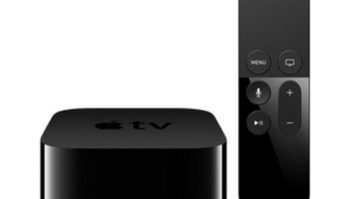Upgrades Include Siri, App Downloads But Not 4K
When the fourth-generation Apple TV hits the market in late October, many of the complaints about the current product will be answered, but questions remain if the Apple logo is enough to fight back against agile competitors.
On the plus side, the new product will be powered by a new 64-bit processor using a new tvOS operating system that will offer Siri voice navigation. And the new Apple TV will include an app store from which users select a wide variety of streaming audio and video services and games. But this is a functionality already offered by game consoles, Android TV, and streaming service products such as Roku and Amazon Fire TV.
Another plus:, the Wi-Fi has been updated to 802.11ac with MIMO, and Bluetooth 4.0 joins IR capability with regard to the remote. On the other hand, the HDMI is the older 1.4 version rather than the expected HDMI 2.0 with the ability to handle 4K video. This is particularly puzzling given that the new iPad Pro and iPhone 6S/6S Plus models have video capture capability approaching 4K.
Perhaps even more important, the lack of the latest HDMI version and 4K capability means that the new Apple TV will be unable to play 4K from the likes of Netflix, M-Go and other services soon to arrive that will feature native Ultra HD content. Remember, HDMI is not upgradable from the 1.4 to 2.0/20.a versions. Further, with HDMI 1.4 instead of the latest version, there may be a concern about the compatibility of the new products with HDR content soon to come from a variety of sources.
The remote for the new-generation Apple TV is clearly an improvement over the current models. It includes a microphone for Siri, up/down buttons, and, as previously mentioned, Bluetooth communication. The most important feature of the new remote is a touch service that can be used to swipe when making selections or to use as a touchpad for control when games are in use. That’s right, the new Apple TV will include games as an option along with traditional video and music programing. Yes, “there is an app for that”.
This advancement, however, is not without some concerns. As with other Bluetooth remotes, you gain the advantage of not having to point the remote directly at the product being controlled but you lose the ability to easily integrate the remote functions into a unified control system. One might be reminded of the accessories that allow the use of third-party remotes with PlayStation yet depend on the game console’s USB remote to serve as a translator between the remote and the device. Because the new Apple TV does not have any USB inputs other than for service, the question remains as how users fold the new remote into complex systems. Yes, there is an IR sensor on the new Apple TV, but it remains to be seen which functions may be copied for use into IR driven systems. Suffice to say, at this point there not an app for that.
We would expect that concurrent with the launch of the new Apple TV there would be a new remote app designed to handle both the touch pad and all other functions from an iOS device, but that too remains to be seen. Further while gaming is touted as a feature of the new product, it also remains to be seen how multiple remotes will be handled in games with multiple players.
Perhaps the most surprising part of the Apple TV announcement, even surpassing the relative absence of 4K capability, was the total silence during Apple’s launch event of anything having to do with the capabilities of the new product with HomeKit or a Health Kit. Many pundits were expecting that the new Apple TV would include a variety of features and functions that would make it more than just another streaming device, but a true home integration hub.
Of course, given the availability of an app store, there is the possibility that some apps may be ported to the new Apple TV. However any overt mention of using the Apple TV, particularly with Siri voice control or a swipe of the touchpad, to adjust HVAC controls, lighting, access controls, or the ability to use an app to view remote cameras, was noticeably absent. We can hope that these capabilities may be added at a later date, but for now the new Apple TV will have to stand or fall as a streaming device for movies, music, and games.
Keep in mind that, based on the life cycle of the current Apple TV, the new the new Apple TV will be around for a while. For those who were hoping to use it for home control will see if, sooner or later, there will be “an app for that.”
For all the capabilities of the new Apple TV and the apps that are central to its success the one app we don’t have is one that will tell the future. But clearly, Apple strives to further the ways in which it can not only capture consumer dollars with its hardware, but also gain an increased share of revenue from streaming, over the top, and game content.
CEDIA fellow Michael Heiss is a contributing editor to TWICE’s sister publication, Residential Systems.













